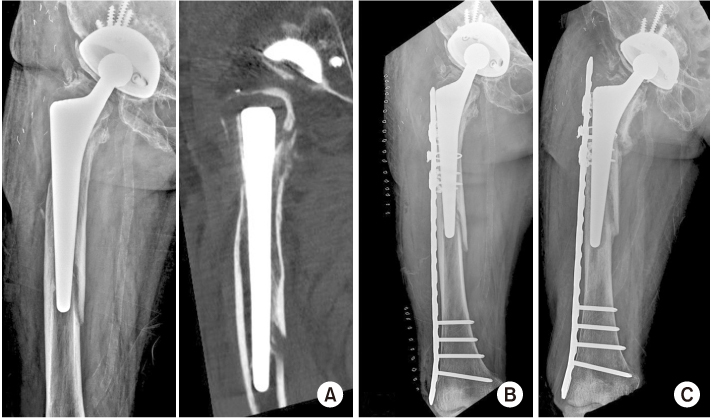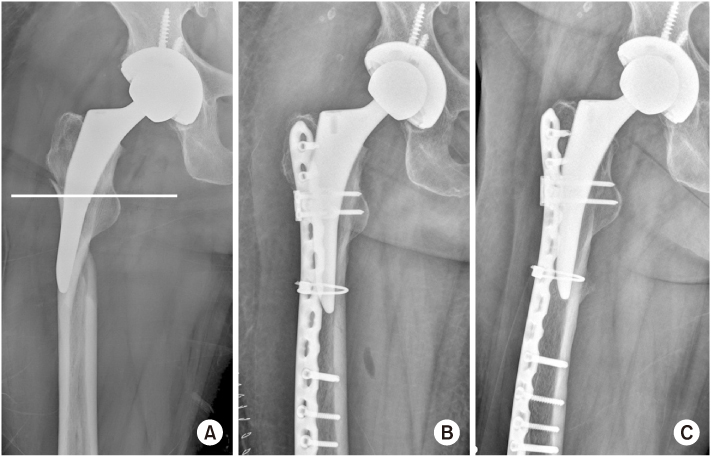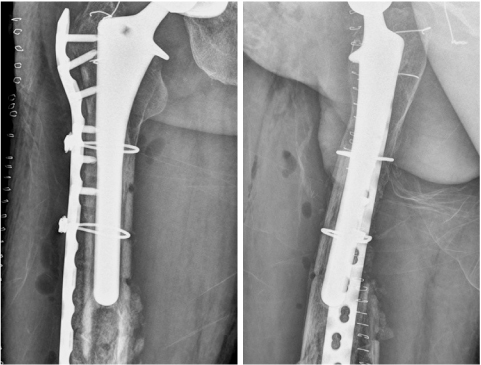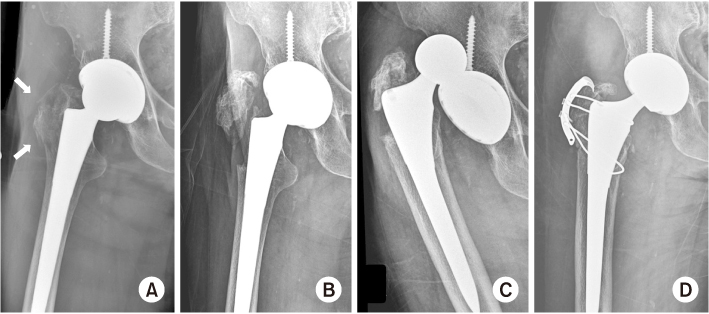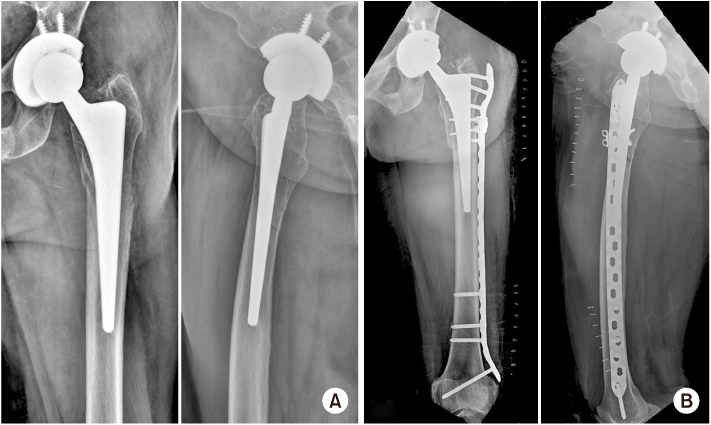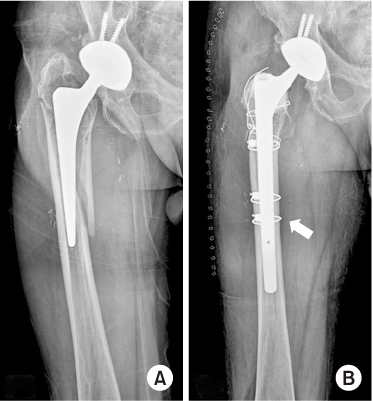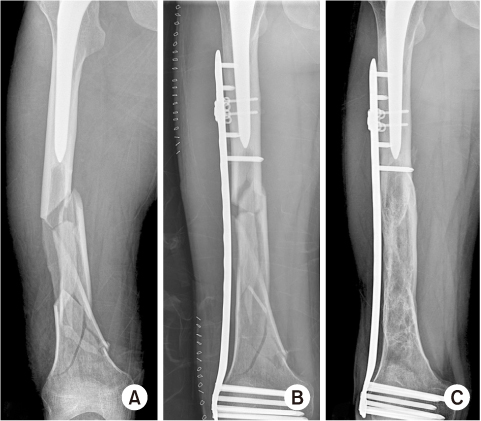J Korean Fract Soc.
2020 Jan;33(1):43-51. 10.12671/jkfs.2020.33.1.43.
Treatment of Periprosthetic Femoral Fractures after Hip Arthroplasty
- Affiliations
-
- 1Department of Orthopedic Surgery, Keimyung University School of Medicine, Daegu, Korea. dream21jh@naver.com
- KMID: 2468674
- DOI: http://doi.org/10.12671/jkfs.2020.33.1.43
Abstract
- Although the incidence of postoperative periprosthetic femoral fractures after hip arthroplasty is expected to increase, these complex fractures are still challenging complications. To obtain optimal results for these fractures, thorough clinical and radiographic evaluation, precise classification, and understanding of modern management principles are mandatory. The Vancouver classification system is a simple, effective, and reproducible method for planning proper treatments of these injuries. The fractures associated with a stable femoral stem can be effectively treated with osteosynthesis, though periprosthetic femoral fractures associated with a loose stem require revision arthroplasty. We describe here the principles of proper treatment for the patients with periprosthetic femoral fractures as well as how to avoid complications.
MeSH Terms
Figure
Reference
-
1. Misur PN, Duncan CP, Masri BA. The treatment of periprosthetic femoral fractures after total hip arthroplasty: a critical analysis review. JBJS Rev. 2014; 2:01874474-201408000-00004.
Article2. Park CW, Oh HK, Lee WS, Park YS, Lim SJ. Principles for management of periprosthetic acetabular fractures after hip arthroplasty. J Korean Fract Soc. 2019; 32:148–156.
Article3. Hwang KT, Kim YH. Treatment of periprosthetic femoral fractures after hip arthroplasty. J Korean Fract Soc. 2011; 24:121–130.
Article4. Stoffel K, Sommer C, Kalampoki V, Blumenthal A, Joeris A. The influence of the operation technique and implant used in the treatment of periprosthetic hip and interprosthetic femur fractures: a systematic literature review of 1571 cases. Arch Orthop Trauma Surg. 2016; 136:553–561.
Article5. Capone A, Congia S, Civinini R, Marongiu G. Periprosthetic fractures: epidemiology and current treatment. Clin Cases Miner Bone Metab. 2017; 14:189–196.
Article6. Bhattacharyya T, Chang D, Meigs JB, Estok DM 2nd, Malchau H. Mortality after periprosthetic fracture of the femur. J Bone Joint Surg Am. 2007; 89:2658–2662.
Article7. Pike J, Davidson D, Garbuz D, Duncan CP, O’Brien PJ, Masri BA. Principles of treatment for periprosthetic femoral shaft fractures around well-fixed total hip arthroplasty. J Am Acad Orthop Surg. 2009; 17:677–688.
Article8. The Korean Hip Society. Textbook of the hip. 2nd ed. Seoul: Koonja;2019. p. 668–679.9. Lindahl H, Garellick G, Regnér H, Herberts P, Malchau H. Three hundred and twenty-one periprosthetic femoral fractures. J Bone Joint Surg Am. 2006; 88:1215–1222.
Article10. Brady OH, Garbuz DS, Masri BA, Duncan CP. Classification of the hip. Orthop Clin North Am. 1999; 30:215–220.
Article11. Naqvi GA, Baig SA, Awan N. Interobserver and intraobserver reliability and validity of the Vancouver classification system of periprosthetic femoral fractures after hip arthroplasty. J Arthroplasty. 2012; 27:1047–1050.
Article12. Duncan CP, Masri BA. Fractures of the femur after hip replacement. Instr Course Lect. 1995; 44:293–304.13. Khanuja HS, Vakil JJ, Goddard MS, Mont MA. Cementless femoral fixation in total hip arthroplasty. J Bone Joint Surg Am. 2011; 93:500–509.
Article14. Abdel MP, Lewallen DG, Berry DJ. Periprosthetic femur fractures treated with modular fluted, tapered stems. Clin Orthop Relat Res. 2014; 472:599–603.
Article15. Otero JE, Martin JR, Rowe TM, Odum SM, Mason JB. Radiographic and clinical outcomes of modular tapered fluted stems for femoral revision for Paprosky III and IV femoral defects or Vancouver B2 and B3 femoral fractures. J Arthroplasty. 2019; DOI: 10.1016/j.arth.2019.11.039. [epub].
Article16. Munro JT, Garbuz DS, Masri BA, Duncan CP. Tapered fluted titanium stems in the management of Vancouver B2 and B3 periprosthetic femoral fractures. Clin Orthop Relat Res. 2014; 472:590–598.
Article17. Hsieh PH, Chang YH, Lee PC, Shih CH. Periprosthetic fractures of the greater trochanter through osteolytic cysts with uncemented MicroStructured Omnifit prosthesis: retrospective analyses pf 23 fractures in 887 hips after 5-14 years. Acta Orthop. 2005; 76:538–543.
Article18. Wang JW, Chen LK, Chen CE. Surgical treatment of fractures of the greater trochanter associated with osteolytic lesions. Surgical technique. J Bone Joint Surg Am. 2006; 88 Suppl 1 Pt 2:250–258.19. Fernandez DL, Capo JT, Gonzalez-Hernandez E, Hinds RM, Müller ME. Nonunion of greater trochanter following total hip arthroplasty: treated by an articulated hook plate and bone grafting. Indian J Orthop. 2017; 51:273–279.
Article20. Zarin JS, Zurakowski D, Burke DW. Claw plate fixation of the greater trochanter in revision total hip arthroplasty. J Arthroplasty. 2009; 24:272–280.
Article21. Tetreault AK, McGrory BJ. Use of locking plates for fixation of the greater trochanter in patients with hip replacement. Arthroplast Today. 2016; 2:187–192.
Article22. Whiteside LA. Surgical technique: transfer of the anterior portion of the gluteus maximus muscle for abductor deficiency of the hip. Clin Orthop Relat Res. 2012; 470:503–510.
Article23. Lindahl H, Malchau H, Herberts P, Garellick G. Periprosthetic femoral fractures classification and demographics of 1049 periprosthetic femoral fractures from the Swedish National Hip Arthroplasty Register. J Arthroplasty. 2005; 20:857–865.24. Choi JK, Gardner TR, Yoon E, Morrison TA, Macaulay WB, Geller JA. The effect of fixation technique on the stiffness of comminuted Vancouver B1 periprosthetic femur fractures. J Arthroplasty. 2010; 25:6 Suppl. 124–128.
Article25. Wilson D, Frei H, Masri BA, Oxland TR, Duncan CP. A biomechanical study comparing cortical onlay allograft struts and plates in the treatment of periprosthetic femoral fractures. Clin Biomech (Bristol, Avon). 2005; 20:70–76.
Article26. Haddad FS, Duncan CP, Berry DJ, Lewallen DG, Gross AE, Chandler HP. Periprosthetic femoral fractures around wellfixed implants: use of cortical onlay allografts with or without a plate. J Bone Joint Surg Am. 2002; 84:945–950.27. Khashan M, Amar E, Drexler M, Chechik O, Cohen Z, Steinberg EL. Superior outcome of strut allograft-augmented plate fixation for the treatment of periprosthetic fractures around a stable femoral stem. Injury. 2013; 44:1556–1560.
Article28. Bryant GK, Morshed S, Agel J, et al. Isolated locked compression plating for Vancouver Type B1 periprosthetic femoral fractures. Injury. 2009; 40:1180–1186.
Article29. Old AB, McGrory BJ, White RR, Babikian GM. Fixation of Vancouver B1 peri-prosthetic fractures by broad metal plates without the application of strut allografts. J Bone Joint Surg Br. 2006; 88:1425–1429.
Article30. Sen R, Prasad P, Kumar S, Nagi O. Periprosthetic femoral fractures around well fixed implants: a simple method of fixation using LC-DCP with trochanteric purchase. Acta Orthop Belg. 2007; 73:200–206.31. Ricci WM, Bolhofner BR, Loftus T, Cox C, Mitchell S, Borrelli J Jr. Indirect reduction and plate fixation, without grafting, for periprosthetic femoral shaft fractures about a stable intramedullary implant. J Bone Joint Surg Am. 2005; 87:2240–2245.
Article32. Abhaykumar S, Elliott DS. Percutaneous plate fixation for periprosthetic femoral fractures: a preliminary report. Injury. 2000; 31:627–630.
Article33. Chakravarthy J, Bansal R, Cooper J. Locking plate osteosynthesis for Vancouver Type B1 and Type C periprosthetic fractures of femur: a report on 12 patients. Injury. 2007; 38:725–733.
Article34. Corten K, Macdonald SJ, McCalden RW, Bourne RB, Naudie DD. Results of cemented femoral revisions for periprosthetic femoral fractures in the elderly. J Arthroplasty. 2012; 27:220–225.
Article35. Kobbe P, Klemm R, Reilmann H, Hockertz TJ. Less invasive stabilisation system (LISS) for the treatment of periprosthetic femoral fractures: a 3-year follow-up. Injury. 2008; 39:472–479.
Article36. Froberg L, Troelsen A, Brix M. Periprosthetic Vancouver type B1 and C fractures treated by locking-plate osteosynthesis: fracture union and reoperations in 60 consecutive fractures. Acta Orthop. 2012; 83:648–652.
Article
- Full Text Links
- Actions
-
Cited
- CITED
-
- Close
- Share
- Similar articles
-
- Periprosthetic Femoral Fractures after Hip Arthroplasty
- Periprosthetic Atypical Femoral Fracture-like Fracture after Hip Arthroplasty: A Report of Three Cases
- Decision-Making and Principle of Management in Periprosthetic Femoral Fracture after Total Hip Arthroplasty
- Management of Ipsilateral Femoral Fracture After Hip Arthroplasty
- Treatment of Periprosthetic Femoral Fractures after Hip Arthroplasty

